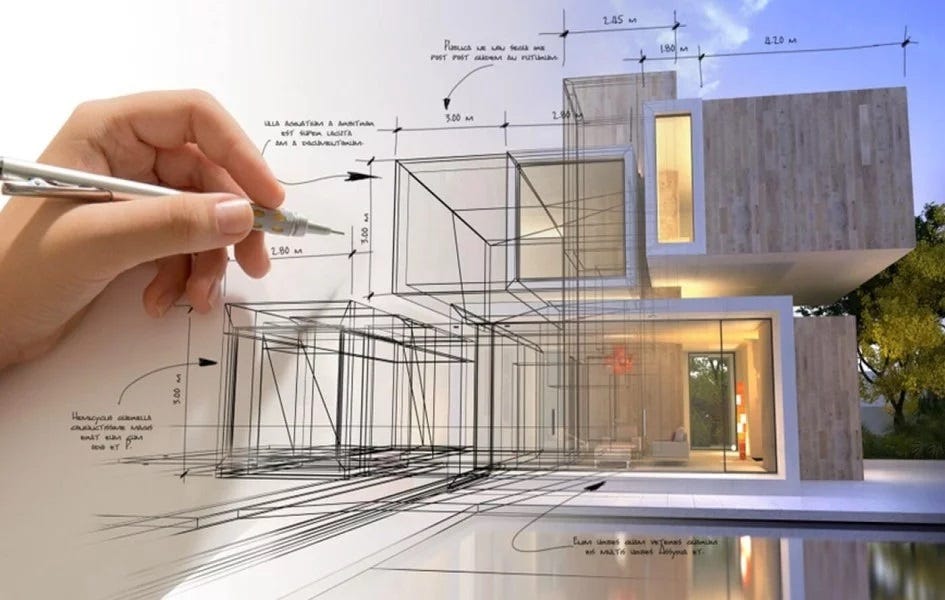With the appearance of new technologies like artificial intelligence and augmented reality, design and construction tools are more capable than ever. However, these technological advancements didn’t just happen overnight.
Since the computer was introduced into the architecture world over fifty years ago, we have seen a steady evolution in digital tools like Autodesk’s AEC Collection and how professionals in the AEC fields utilize them.
The Evolution of Digital Tools in Construction
Over the past decades, design and construction tools have seen waves of improvements rather than replacements. This natural progression has allowed software engineers to build upon existing platforms, resulting in incredibly powerful pieces of software.
Take Autocad, for example. This cutting-edge drafting program was first released to the public in 1882. Since its introduction, it has undergone countless updates. Because of the steady stream of improvements, it still enjoys its place as the industry standard for 2D drafting programs over 40 years later.
The History Of CAD and Its Role in Design and Construction
Computer-aided design (CAD) has played a pivotal role in the revolution of digital design tools. CAD first became popular among architects in the 1960s, who previously relied on pen and paper to create their designs.
This state-of-the-art design tool facilitated extreme levels of precision that had previously been achievable. Additionally, CAD saved architects and engineers massive amounts of time. Hand drawing was a painfully slow process compared to modern drafting, even for the most experienced drafters.
With computerized drafting technology, work that would usually take hours could now be completed in a matter of minutes. CAD’s use in construction has enabled the detailed planning, visualization, and simulation of construction projects before the actual building begins.
While many argued that CAD’s introduction removed the need for artistic ability from the design process, the overall efficiency of CAD simply couldn’t be ignored and spelled certain death for hand drawing as an architectural standard.
The Evolution of 3D Modeling and Its Impact on Construction Fields

While 2D drafting still proves to be valuable in a design toolbox, most architects will tell you that it is gradually being phased in favor of 3D modeling tech.
Building information modeling (BIM) and 3D modeling aren’t exactly new, but they previously existed independently of 2D drafting. 3D was for conceptual design and product presentation, while 2D was for construction. Each discipline required its own individual processes and, in many cases, separate technicians.
However, modern 3D modeling software combines the two disciplines. Programs such as Autodesk Revit can automatically generate 2D plansets while an engineer creates a 3D BIM model of a structure, saving time, money, and manpower. Due to technological advancements like these, some say that 2D modeling will soon disappear like hand drawing before it.
Emerging Technologies Redefining Construction and Design
As the design and construction landscape progresses further into the digital age, new technology, and tools are redefining what is possible when planning and building a structure. These emerging technologies include virtual and augmented reality, AI tools, BIM, and the digital-twin design concept.
- AI tools– Like many other industries, AI (artificial intelligence) tech has made its way into construction and design. AI can automatically assist engineers in detecting clashes in design, comply with local building codes, and streamline the project rendering process.
- AR and VR visualization – Visualizing the final product is often difficult for clients and shareholders. With AR (augmented reality) and VR (virtual reality) technology, an individual can see a building in first person, walking around in the space as if they were actually there.
- BIM– building information modeling, or BIM, can help create digital representations of a structure’s physical and functional characteristics that can help engineers, builders, and stakeholders improve efficiency and collaboration.
- Digital Twins– Digital twins are a relatively new concept in the design and construction world. The principle idea involves creating a virtual replica of a building that is fed real-time data through sensors to reflect exact conditions. The digital twin concept is especially effective for building managers looking to optimize their maintenance routines.
Real-World Application of New Design Technology
Modern construction is complicated and, in many cases, expensive. Fortunately, implementing modern design technology has helped countless design and construction firms optimize their project planning and reduce overall expenses.
For example, in one case study conducted by Diponegoro University in Indonesia, it was discovered that on one construction project, by implementing BIM technology, construction duration was cut down by roughly 50%, and the overall cost savings were estimated to be 52.36%. Clearly, modern construction firms can benefit greatly by taking advantage of these cutting-edge new technologies.
The Role of Digital Integration in Project Lifecycle
Construction projects typically have four main phases: design, planning, construction, and operation. Integration of modern digital design tools can optimize performance in every phase.
Digital Tools Can Be Used Before and After Construction
While novel design tools like BIM, AI, and AR play a big part in the design and planning phases of a building, their uses don’t stop once construction comes to an end.
When a project enters the operational phases, these technologies can help identify the ideal moment to perform predictive and preventative maintenance, helping building owners and facility managers make the best use of allocated funds and ensure that building systems are utilized to their full potential before being replaced.
Digital Integration Leads to Improved Efficiency, Accuracy, and Better Decision-Making
Modern design tools excel at delivering data to architects, engineers, and facility managers. This information often comes through in real time via sensors placed on a building project itself.
This steady flow of data helps everyone involved make informed decisions, leading to more accurate quantity takeoffs, quicker turnarounds, and improved efficiency.
Challenges and Solutions in Adopting Digital Technologies

Though the benefits of modern design tools are plentiful, adopting them into an everyday workflow comes with challenges. Upgrading to new software often represents a significant investment for a firm, and once purchased, many of these programs have a steep learning curve that requires time and effort from design team members.
So, what can help a design and construction firm overcome the initial shock of purchasing a new piece of tech?
Those entrusted with the responsibility of purchasing new tech for a team should take a step back and see the big picture. Rather than focusing on the initial price tag, they can see it as an investment and an opportunity to drive the business into the future.
When a company is able to stay up-to-date and adapt to modern technology, it fosters a culture of innovation and helps to ensure that they don’t get left behind by competitors.
Modern Design Technology, Driving the Construction into the Future
One by one, every technology, tool, and software program helps to reshape the architecture, engineering, and construction fields. These innovations represent more than just a solution to modern building-related challenges; rather, a huge step forward into a world of safer, more sustainable construction.











